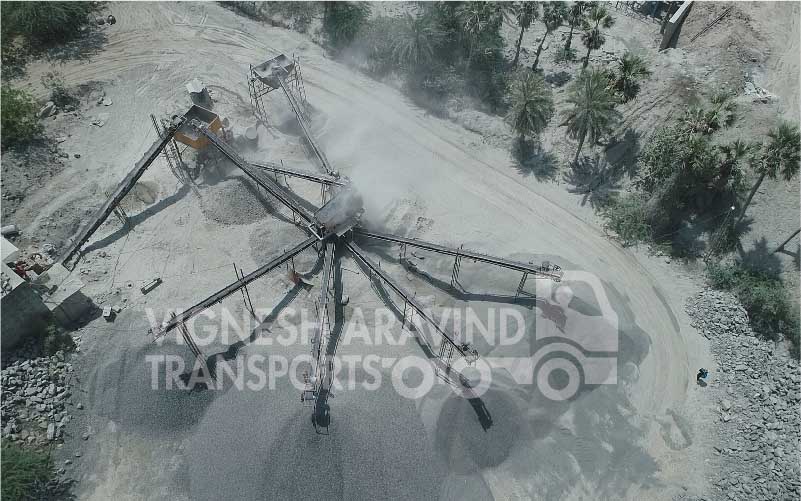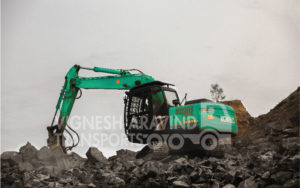M Sand Manufacturers in Chennai, M Sand In Chennai – VAT


M Sand Manufacturers In Chennai
Vignesh Aravind Transport is the best M Sand Manufacturers In Chennai, Provides variety of sand supplies all over Chennai and tamilnadu
Secondary Crusher:
The output of Jaw crusher is fed to Secondary crusher i.e. a Cone Crusher. The feed size -150 mm rock is crushed to -40 mm size. Cone crusher consists of two truncated cones with different diameters. Initially these two truncated cones are called Concave and Mantle, which are made of Manganese alloy. Similarly rocks are crushed in between the chamber of Concave and Mantle.
Tertiary Crusher:
This is the final crushing stage, where the output of Cone Crusher is fed to Vertical Shaft Impactor (VSI) through screens. M sand is produced from the output of VSI as an end product. The VSI crusher, by means of its unique design and action, produces well-shaped fine aggregate particles.
How advantageous is M-sand over natural sand?
Manufactured sand is made mechanically from bedrock by pulverizing and grinding it into tiny particles with the use of crushers that are designed to meet sand standards. At Vignesh Aravind Transports, the best m-sand suppliers in Chennai, this process guarantees the creation of a premium aggregate that satisfies certain application requirements,
Consistency in Structure: The overall quality of our manufactured sand is higher than that of natural sand because of its more consistent structure.
Effective in Concrete Production: It requires 5 to 20% less artificial sand than natural sand to fill the spaces between particles in concrete mixes, making it more efficient.
Energy Use vs. Cost Savings: Our on-site production reduces environmental effects and transportation expenses while consuming less energy during production.
There will certainly be a growing need for artificial sand in the future. Superior raw ingredients are necessary for superior concrete. Sand can make up as much as 30% to 40% of the major ingredients in concrete, or even more, depending on the mix design, but it has a significant impact on how much cement is needed to obtain the desired concrete qualities. In this case, the cost of the cement will account for half on average of the overall mix cost.
Thus, as leading sand suppliers in Chennai, our premium sand not only elevates concrete quality but also provides expensive cutouts when it comes to producing high-quality concrete.
When the stones are processed through the Vertical Shaft Impact Crusher, not only fine aggregates, but also coarse aggregates, another end product, acquire improved particle shape and reduced surface roughness. Manufactured Sand plants ensure better grading of fine aggregates for better particle size distribution. Few plants are equipped with air filter systems and/or washing facilities, which maintains micro fine sand particles (the ones passing 75 micron) 3% by weight.
Process of M-sand manufacture:
A pioneer in environment-friendly building supplies, Vignesh Aravind Transports, one of the reputed m-sand manufacturers in Chennai, is known to produce quality M-sand. It is an excellent substitute for river sand.
To guarantee that we use only the highest calibre raw materials, and our manufacturing process starts with the meticulous selection of firm granite rocks.
These rocks go through many steps of crushing and screening with the use of cutting-edge gear and technologies to get the ideal granularity and form for plastering and high-strength concrete.
We ensure clean and excellent products by removing contaminants via many steps of water washing.
Our M-sand is the go-to option for building projects that prioritize quality and environmental consciousness due to our unwavering dedication to both.
Finding an apt m sand suppliers for concrete construction? We have got you something to build high your expectations. Yes, we are talking about Vignesh Aravind Transports.
Manufactured sand (M-Sand), the superior substitute for river sand, is cubically shaped and fine-grated. This is ideal for your construction purpose. Vignesh Aravind Transports is one of the main M sand suppliers with government accredited.
We help you to reinforce the durable concrete structure which you wish for! Buy your needs and strengthen your construction!
Washing provides an added benefit of keeping Manufactured Sand wet or in partially wet conditions. Though this helps reduce the water absorption rate of Manufactured Sand concrete preparation which in turn contribute to the better workability and workability retention.

Technical specifications for M Sand
The composition of sand is highly variable, depending on the local rock sources. But the most common constituent of sand is silica (silicon dioxide, or SiO2), usually in the form of quartz.
M Sand Manufacturers in Chennai
Improved and well-functioning M Sand value chain, adoption of IS standards among all M Sand manufacturers in chennai leading to better quality. Consistency, improved accessibility and adoption among end consumers. But better skills among construction labour to use M Sand appropriately and finally better policy environment are vital to meet the growing demand. For new constructions and to prevent the natural disasters such as flooding, ecological imbalances created by indiscriminate river sand mining. But the size of the housing deficit in India to the tune of 90 million units by 2022. The huge demand for sand required in construction make a compelling case for a market systems approach to help housing and construction markets be more responsive and ecologically sensitive.
VAT – M Sand Supplies Chennai
To advance such initiatives, the Terwilliger Center for Innovation in Shelter is looking to support the M-Sand sector stakeholders. With technical knowledge to make the M Sand value chain more inclusive and sustainable. Manufacturers, distributors and aggregators, professional associations and academics can apply to join the program by sending an expression of interest for a chance to receive financial and technical support, benefiting from Habitat’s expertise and latest findings from on-going research and global best practices.
Aggregate Supplies in Chennai
Fineness Modulus (FM): Aggregate sieve analysis results denoted in Fineness Modulus.
Manufactured Sand, alternatively known as M-Sand, is an efficient replacement for natural river sand, specifically in the making of concrete.
The manufactured sand has several benefits that overlook the other natural sands:
Conservation of Natural Resources – The extraction of natural sand from rivers degrades the ecosystem. By lessening the need for river sand, M-Sand can aid in protecting natural ecosystems.
Availability – M-Sand may be produced in vast numbers and is more widely available than natural sand, which may be subject to legal and environmental constraints.
With cutting-edge technologies, the M-Sand Manufacturers in Chennai produce them by crushing granite stone and rounding off its rough edges, producing a consistent material for construction. Some of its hyped-up qualities are:
Enhanced Durability
Vignesh Aravind Transports, one of the prominent m-sand manufacturers in Chennai, supplies M-sand that enhances the longevity of concrete, making structures more resistant to environmental pressures.
Improved Strength
Concrete formulated with M-Sand from top manufacturers in Chennai showcases greater compressive strength as a result of the angular shape and rough texture of M-Sand particles, which create stronger bonds within the concrete framework.
Cost-Effective Transportation
Chennai’s local availability of m-sand allows the best companies like Vignesh Aravind Transports to offer economical transportation solutions, effectively reducing the overall expenses of construction materials.
Flexible Grading and Sizing
Vignesh Aravind Transports offers accurately graded and sized M-Sand, leading to fewer empty spaces in the concrete mixture and a more solid and robust structure.
Erosion Prevention
By opting for M-Sand, river sand extraction is minimized, thus preventing riverbank erosion and the associated environmental problems. This responsible choice is strongly advocated by VAT, the best m-sand manufacturers in Chennai.
Consistent Supply
Vignesh Aravind Transports ensures a reliable and uninterrupted supply of M-Sand, overcoming the seasonal fluctuations that often affect the availability of river sand. This makes them a trustworthy choice among m-sand manufacturers in Chennai.
Technical Excellence
M-Sand offers superior finishes for buildings and infrastructures, which is why Vignesh Aravind Transports, as one of the leading m-sand manufacturers in Chennai, invests in the latest technology for manufacturing M-Sand.
Reduction in Water Usage
M-Sand requires less water for concrete curing compared to river sand. This contributes to water conservation efforts, a practice that Vignesh Aravind Transports prioritizes and values.
Choosing M-Sand supplied by Vignesh Aravind Transports not only guarantees quality and sustainability but also shows support towards the preservation of natural habitats and the conservation of resources. In doing so, Vignesh Aravind Transports further solidifies its position as a leading M-Sand manufacturer in Chennai.
The latest Indian Standard IS: 383- 2016 “Coarse and Fine Aggregates for Concrete- Specification (Third Revision)” covers the requirements for aggregates. Crushed or uncrushed, derived from natural sources. Such as river terraces and river beds, glacial deposits, rocks, boulders and gravels. Manufactured aggregates produced from other than natural sources, for use in the production of concrete. For normal structural purposes including mass concrete works.
M-Sand for concreting- But its granule thickness/sieve size is 150 Microns-4.75 mm and also adheres to IS Code 383:1970
M-Sand for plastering- Whereas Wall plaster and tiling purposes. But its granule thickness/sieve size is 150 Microns-2.36 mm and this adheres to IS Code 1542:1992
M-sand for Brick work- Used in Masonry, block laying and brick work. Although its granule thickness is 150 microns-3.55mm and it adheres to IS Code 2116:1980
Essential Tips for Choosing the Right M-Sand Manufacturers in Chennai :
Reputation Matters: Choose from the best M-sand manufacturers in Chennai, such as us, Vignesh Aravind Transports, as we are well-known for our dependability and consistency.
Quality certificates: Confirm that the manufacturer has the required quality certificates, assuring that the M-sand satisfies industry requirements.
Production Technology: Choose manufacturers who use innovative manufacturing technology to provide finer and more consistent sand.
Customer Reviews: Read reviews and testimonials to determine customer satisfaction and service quality.
Transparent price: Ensure that the manufacturer provides a transparent and competitive price without sacrificing sand quality.
By emphasizing these elements, we at Vignesh Aravind Transports demonstrates our dedication to being one of the top M-sand manufacturers in Chennai.
Article Source : MasterBuilder
Read More:
- Manufacture of M-Sand Chennai
- Concrete Mix Design Using Crushed Sand
- Advantages of M- Sand
- Filling Sand Suppliers In Chennai
